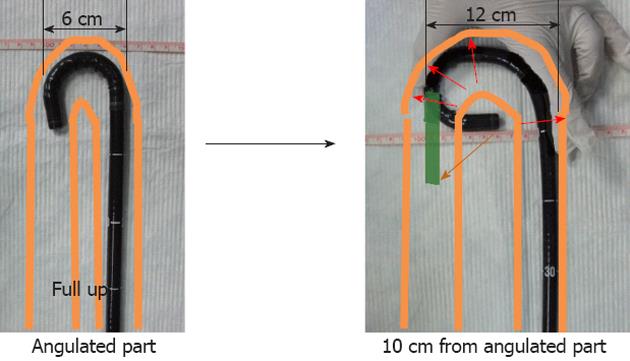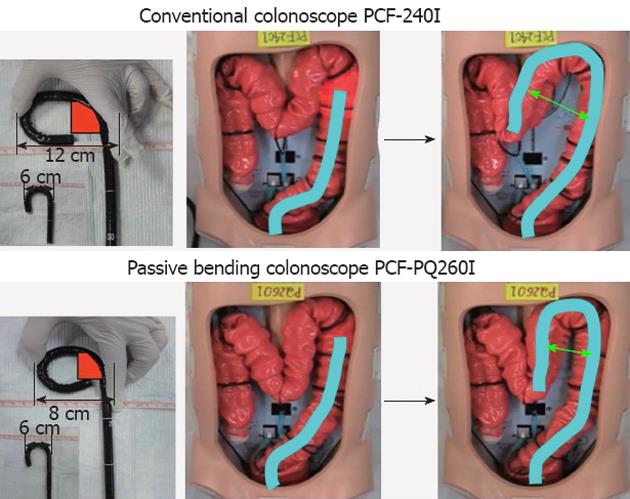Published online Aug 28, 2012. doi: 10.3748/wjg.v18.i32.4454
Revised: July 20, 2012
Accepted: July 28, 2012
Published online: August 28, 2012
Colonoscopy sometimes causes pain during insertion, especially in difficult cases. Over-insufflation of air causes elongation or acute angulations of the colon, making passage of the scope difficult and causing pain. We previously reported a sedative-risk-free colonoscopy insertion technique, namely, “Water Navigation Colonoscopy”. Complete air suction after water infusion not only improves the vision, but also makes water flow down to the descending colon, while the sigmoid colon collapses and shortens. While non-sedative colonoscopy can be carried out without pain in most cases, some patients do complain of pain. Most of these patients have abnormal colon morphology, and the pain is caused while negotiating the “hairpin” bends of the colon. The “hairpin” bends of the colon should be negotiated by gently pushing the full-angled colonoscope. The proximal 10-20 cm from the angulated part of the conventional colonoscope is stiff, with a wide turning radius, therefore, a conventional colonoscope cannot be negotiated through the “hairpin” bends of the colon without stretching them and causing pain. The “passive-bending colonoscope” has a flexible tip with a narrow turning radius, so that the scope can be negotiated through the “hairpin” bends of the colon with a minimum turning radius and minimal discomfort. Therefore, the intubation and pain-reducing performance of the “passive-bending colonoscope” was assessed in difficult cases.
- Citation: Mizukami T, Ogata H, Hibi T. “Passive-bending colonoscope” significantly improves cecal intubation in difficult cases. World J Gastroenterol 2012; 18(32): 4454-4456
- URL: https://www.wjgnet.com/1007-9327/full/v18/i32/4454.htm
- DOI: https://dx.doi.org/10.3748/wjg.v18.i32.4454
Colonoscopy sometimes causes pain during insertion, especially in difficult cases. Over-insufflation of air causes elongation or acute angulations of the colon, making passage of the scope difficult and causing pain.
Administration of sedatives masks pain, which is a warning sign of perforation. Therefore, we developed a sedative-risk-free colonoscopy insertion technique, namely, “Water Navigation Colonoscopy”[1,2] (Figure 1). Complete air suction after water infusion not only improves the visibility, but also makes the water flow down to the descending colon, while the sigmoid colon collapses and shortens. The Water Methods were reported to reduce pain and make it possible to perform colonoscopy without the use of sedatives[3]. While non-sedative “Water Navigation Colonoscopy” can be carried out without pain in most cases, some patients do complain of pain. Most of these patients have abnormal colon morphology, and the pain is caused while negotiating the “hairpin” bends of the colon[4,5]. The “hairpin” bends of the colon should be negotiated by gently pushing the full-angled colonoscope. The proximal 10-20 cm from the angulated part of the conventional colonoscope is stiff, with a wide turning radius, therefore, a conventional colonoscope cannot be negotiated easily through the “hairpin” bends of the colon without stretching them or causing pain (Figure 2).
“Passive-bending colonoscope,” PCF-PQ260 (Olympus Co, Tokyo, Japan), has a flexible tip with a narrow turning radius, so that the scope can be easily negotiated through the “hairpin” bends of the colon, with minimal discomfort[6,7] (Figure 3).
The subjects were 11 patients, including 2 cases of cecal intubation failure and 9 cases of difficult colonoscopy with the “conventional colonoscope,” PCF-240Z Olympus, who underwent a second colonoscopy with the “passive-bending colonoscope,” PCF-PQ260, more than 7 d after the first procedure. All colonoscopies were performed by the same physician, Mizukami T. Colonoscopy was performed according to the method of “Water Navigation Colonoscopy”. The cecal intubation time was measured and the patients were asked to report their level of discomfort after the colonoscopy on a visual analog scale of 1 to 5, as follows: grade 1, no discomfort; grade 2, strange feeling; grade 3, distension of the abdomen; grade 4, tolerable pain; grade 5, intolerable pain. Computed tomographic colonography (CTC) was performed for morphological evaluation. Cecal intubation was accomplished successfully in all cases and the intubation time was significantly shortened with the use of the “passive-bending colonoscope” (n = 9) (10.1 ± 3.2 min vs 5.1 ± 2.8 min, P < 0.05). The average self-reported pain score was also significantly lower in the “passive-bending colonoscope” group (3.7 ± 0.6 vs 2.3 ± 0.9, P < 0.01). CTC showed that every patient had “hairpin” bends of the colon. PCF-PQ260 significantly shortened the cecal intubation time and reduced the pain score in difficult cases, and CTC showed that every case had “hairpin” bends of the colon. This showed that the “passive-bending colonoscope” can be negotiated more easily through the “hairpin” bends of the colon, with its minimum turning radius. Use of the “passive-bending colonoscope” shortens the cecal intubation time and reduces pain in difficult cases.
This patient (78-year-old female) had sigmoid malrotation and loops at the splenic flexure. The cecal intubation time was 11 min (conventional), and 6 min (passive bending). The level of discomfort was 4 (conventional), and 2 (passive bending, Figure 4A).
This patient (70-year-old female) had sigmoid malrotation and mesocolon descendens. The 1st cecal intubation (conventional) failed because of the “hairpin” bends at the splenic flexure. The 2nd cecal intubation (passive bending) was accomplished in 11 min. The level of discomfort was 4 (conventional), and 2 (passive bending, Figure 4B).
This patient (70-year-old female) had mesocolon descendens and ascendens. The 1st cecal intubation (conventional) failed because of the “hairpin” bends in the descending colon. The 2nd cecal intubation (passive bending) was accomplished in 11 min. The level of discomfort was 4 (conventional), and 2 (passive bending) (Figure 4C).
Cases with difficult cecal intubation have looping and “hairpin” bends of the colon[4,5]. There are some reports suggesting that the use of a variable-stiffness colonoscope or a pediatric colonoscope can reduce pain and facilitate intubation[8,9].
In conventional colonoscopes, the 10-20 cm segment proximal to the angulated part is stiff, which causes stretching and pain during negotiation of the scope through the “hairpin” bends of the colon. The “passive-bending colonoscope” has a flexible tip with a narrow turning radius and can be more easily negotiated through the “hairpin” bends of the colon, with its minimum turning radius. Use of this scope in difficult cases was associated with a significantly shortened cecal intubation time and reduced pain score. CTC showed that every case had “hairpin” bends and loops of the colon, indicating that the “passive-bending colonoscope” could be negotiated through the “hairpin” bends of the colon relatively easily, with its minimum turning radius. In conclusion, use of the “passive-bending colonoscope” with “Water Navigation Colonoscopy” significantly shortens the cecal intubation time and reduces pain in difficult cases.
Peer reviewer: Dr. Jeff Butterworth, MB, FRCP, Department of Gastroenterology, Shrewsbury and Telford Hospital NHS Trust, Mytton Oak Road, Shrewsbury, Shropshire SY3 8XQ, United Kingdom
S- Editor Gou SX L- Editor A E- Editor Li JY
| 1. | Mizukami T, Yokoyama A, Imaeda H. Collapse-submergence method: simple colonoscopic technique combining water infusion with complete air removal from the rectosigmoid colon. Dig Endosc. 2007;19:43-48. [RCA] [DOI] [Full Text] [Cited by in Crossref: 18] [Cited by in RCA: 18] [Article Influence: 1.0] [Reference Citation Analysis (0)] |
| 2. | Mizukami T, Toshifumi Hibi. How I teach my trainees “Water Navigation Colonoscopy”. AJCM. 2010;7:144-146. |
| 3. | Leung FW. A hypothesis-generating review of the water method for difficult colonoscopy. Scand J Gastroenterol. 2011;46:517-521. [RCA] [PubMed] [DOI] [Full Text] [Cited by in Crossref: 8] [Cited by in RCA: 13] [Article Influence: 0.9] [Reference Citation Analysis (0)] |
| 4. | Shah SG, Brooker JC, Thapar C, Williams CB, Saunders BP. Patient pain during colonoscopy: an analysis using real-time magnetic endoscope imaging. Endoscopy. 2002;34:435-440. [RCA] [PubMed] [DOI] [Full Text] [Cited by in Crossref: 92] [Cited by in RCA: 100] [Article Influence: 4.3] [Reference Citation Analysis (0)] |
| 5. | Luo M, Shan H, Zhou K. CT virtual colonoscopy in patients with incomplete conventional colonoscopy. Chin Med J (Engl). 2002;115:1023-1026. [PubMed] |
| 6. | Hoff G, Bretthauer M, Huppertz-Hauss G, Sauar J, Paulsen J, Dahler S, Kjellevold Ø. Evaluation of a novel colonoscope designed for easier passage through flexures: a randomized study. Endoscopy. 2005;37:1123-1126. [RCA] [PubMed] [DOI] [Full Text] [Cited by in Crossref: 10] [Cited by in RCA: 11] [Article Influence: 0.6] [Reference Citation Analysis (0)] |
| 7. | Saito Y, Kimura H. Responsive insertion technology. Dig Endosc. 2011;23 Suppl 1:164-167. [RCA] [PubMed] [DOI] [Full Text] [Cited by in Crossref: 9] [Cited by in RCA: 13] [Article Influence: 0.9] [Reference Citation Analysis (0)] |
| 8. | Shumaker DA, Zaman A, Katon RM. Use of a variable-stiffness colonoscope allows completion of colonoscopy after failure with the standard adult colonoscope. Endoscopy. 2002;34:711-714. [RCA] [PubMed] [DOI] [Full Text] [Cited by in Crossref: 35] [Cited by in RCA: 35] [Article Influence: 1.5] [Reference Citation Analysis (0)] |
| 9. | Marshall JB, Perez RA, Madsen RW. Usefulness of a pediatric colonoscope for routine colonoscopy in women who have undergone hysterectomy. Gastrointest Endosc. 2002;55:838-841. [RCA] [PubMed] [DOI] [Full Text] [Cited by in Crossref: 46] [Cited by in RCA: 48] [Article Influence: 2.1] [Reference Citation Analysis (0)] |












